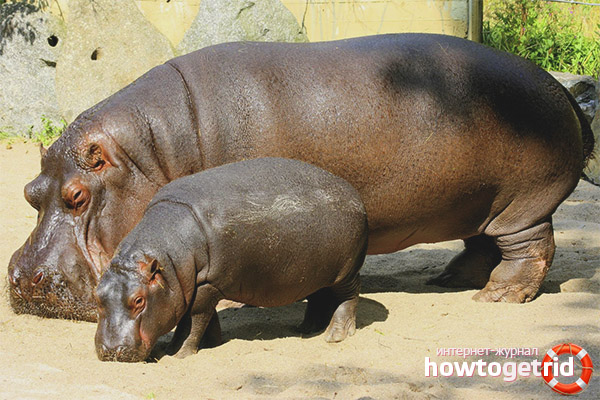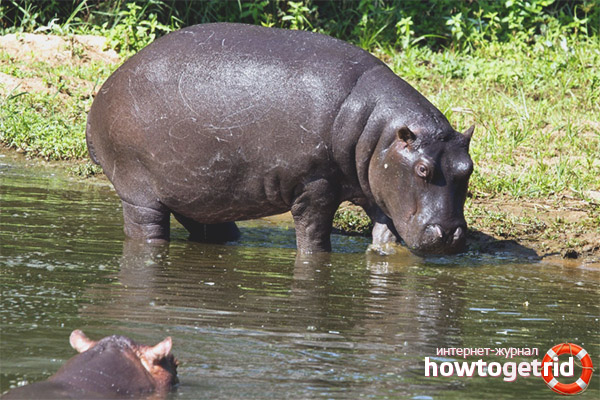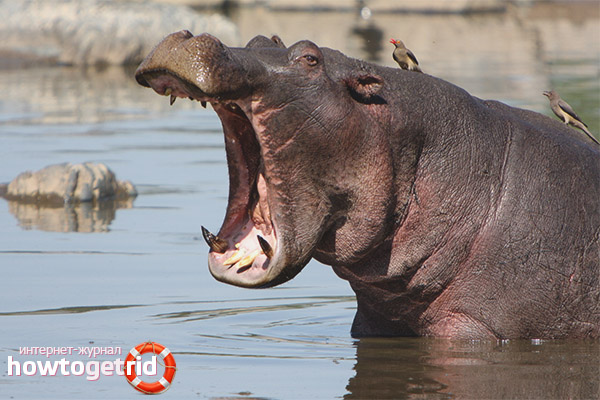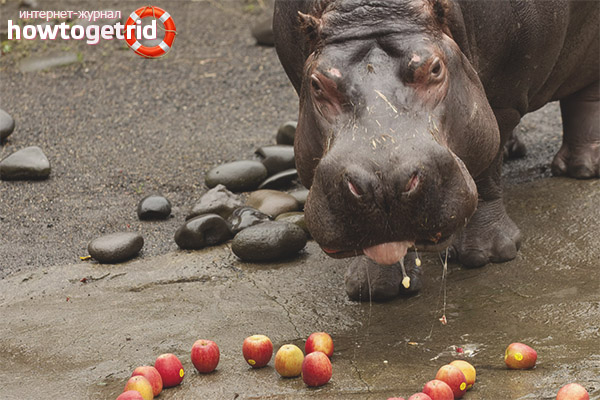The content of the article
Hippos are also called hippos, belong to artiodactyl mammals. Their family is called hippopotamus. They are considered one of the largest animals on earth and lead a rather interesting lifestyle.
Description
Hippos are the second heaviest animals on earth. Elephants take the first place, and rhinos are in the third place.
Scientists have long wanted to determine the origin of hippos, their pedigree from ancient times. For a long time, researchers thought the hippos had the strongest family ties with pigs. This was indicated by their similar appearance. But recent studies have proven that hippos are related by origin to whales. This explains their semi-aquatic lifestyle.
The hippo body is protected by a thick layer of skin. They can take colors from violet-gray to gray-green. Skin color changes in the areas around the eyes, as well as around the ears of the animal. Here the skin may be brownish pink.
The weight of an adult hippo can reach 4000 kilograms. On average, these animals weigh between 1.3 and 3.2 tons. Hippos have a tail, its length can reach thirty-five centimeters. The body itself has a length of two to five meters. The height of an adult animal varies from 1.5 to 1.6 meters.
During contractions in the wildlife, the hippo can be injured, because the outer layer of their skin is not too strong. Hippos have almost no wool, the hairs covering the body are thin, almost invisible. More abundant wool can only be seen on the head and tail of the animal.
Interestingly, hippos have neither sweat nor sebaceous glands. Instead of the naturally occurring discharge that is usual for us, their glands produce a viscous red liquid. At first, the researchers thought this fluid was a mixture of sweat and blood. But long research has shown that these are actually two acids mixed together. In combination with each other, they protect the skin of the animal from overheating, and also have the effect of antiseptic and antibacterial agents. Under the influence of sunlight, the liquid on the skin of a hippo changes color. If at first it is transparent, then it becomes brick in color.
It is a mistake to consider hippos as inactive, slow and awkward. In order to protect their life and the life of the family, these animals can move in their habitat quite quickly.
On land, they can move at a speed of 30 km / h. And to maintain such speed for a long time. In water, hippos can become even faster, this is due to the structure of their limbs, which are adapted for movement in shallow waters.
Another interesting fact is that the structure of the head of the hippo, namely, its ears, nostrils and eyes, allows these animals to not swim to the surface for a long time, being under a layer of water, escaping from danger. In this case, the animal can fully control what is happening around it. If a hippopotamus completely wants to go under water, then it closes its ears and eyes, protecting them from water.
If we talk about the teeth and jaws of a hippopotamus, they can seem quite formidable animals. Their fangs can reach a length of fifty centimeters, and the incisors can be the size of forty centimeters. At the same time, hippos can open their mouth at an angle of more than 150 degrees, which looks very intimidating. But it must be said that such a structure of the jaw meets the needs of chewing a large amount of grass, and not hunting other animals.
It should be noted that in hippos gender is clearly traced. Males are much larger than females.Female hippos weigh only 200 kilograms, while male hippos can weigh several tons. Females grow for a limited amount of time, and males can grow larger throughout their lives. The jaws of males also look most intimidating, compared with females.
The largest hippo recorded by the researchers weighed more than 4.5 tons.
Habitat
Hippos love to live in shallow water, it can be shallow swamps, rivers or lakes. These animals need the body to completely submerge under water, so the depth of the reservoirs should be about two meters.
In the daytime, hippos do not lead an active lifestyle. At the height of the day, animals become sleepy; they can sleep in shallow ponds or even in mud. At the same time, hippos never rest alone, they sleep in groups, their bodies touch. Mating acts and childbirth themselves can also occur here.
If hippos during the day for some reason cannot be in shallow ponds, they will be immersed in deep waters. At this time, only nostrils are located above the water surface in these animals. This position allows them to breathe, as well as to be unnoticed by others.
When evening comes in nature, and the bright sun has almost gone beyond the horizon, hippos wake up and begin to conduct their active activities in obtaining food, as well as just to move around and change their location. Hippos always choose familiar paths; only danger can make them change their place to sleep. From familiar reservoirs they do not go further than two kilometers, unless there are emergency situations. At the same time, they prefer to move in their usual environment along the shores of water bodies.
Scientists cannot provide data on the size of the territory occupied by hippos. The area of the territory depends on how many hippos are in the herd. At the same time, as mentioned earlier, hippos never rest alone, preferring close company and contact with each other.
To date, most often hippos are found only on the African continent. Previously, they met in other places, but were killed due to poaching. These animals were hunted for meat.
Hippo lifestyle
Hippos never live alone. This is due to their long-standing habits from the moment they appeared. One flock of hippos can count from 20 to 100 animals. The group habitat is explained by safety, few predators are able to attack a group of such large animals. As already mentioned, the main activity in the life of a hippo occurs with the arrival of the evening. Only then do hippos begin to search for food for themselves and their offspring.
The role of males in a herd of hippos is to ensure the protection and safety of females and cubs. Females provide a calm and measured sleep in the daytime on the shore or in shallow water, they control their cubs, letting everyone enjoy their vacation.
It is important to note that male hippos are characterized by aggressive behavior. When the male reaches the age of seven, he becomes a full member of the group. This event gives rise to his struggle for territory and position in the herd. There are various methods for this in the animal kingdom. This includes roaring, and the wide opening of the mouth, and spraying other individuals with manure and urine.
Thus, they want to show their strength and power, but it can be very difficult for young males to strengthen their position in the herd. Here, their rivals are adult hippos who are ready to engage in battle with their relatives for a place in the sun. Last resort may be the killing of a young rival.
Males very carefully monitor the territory belonging to them.They take possession with the help of notes. Males refer to their territory and places for rest, and places for food. Even if male hippos do not see other applicants, they still mark their possessions. To conquer and capture new places, hippos can even get out of the water after school hours.
Hippos communicate with each other through sounds. Hippos always warn each other of danger. They can also propagate sound waves in water. Their roar can be compared to the roar of thunder during a thunderstorm. In the entire animal world, only hippos can communicate with each other under the water. Their roar is heard for relatives, both on land and in the water. Hippos are capable of transmitting sound messages to each other even when only his nostrils rise above the water.
At that moment, when the body of the hippo is immersed in water, the head of this animal can serve as an island for birds, from where they can catch fish and get their own food. Hippos reacts calmly to birds. This is due to the existence of a tandem between them. This union is justified in that the birds help the hippopotamus to get rid of the parasites that live on its entire body. Unpleasant worms that can cause a lot of inconvenience can live even near the eyes of a hippo. Birds feed on these parasites, making life easier for hippos.
Such an alliance with birds can be considered an exception, since hippos are not at all calm and peaceful animals. They are dangerous in their habitat. With the help of powerful jaws, hippos are able to instantly kill even a crocodile.
The behavior of hippos is often unpredictable, especially this unpredictability is characteristic of males and females who protect their cubs. If another animal angered a hippopotamus, then he is able to kill him. This can happen under different circumstances. A hippo can gnaw its victim's throat, trample it, tear it with fangs, or simply drag it with it to the depths.
Food
For all their apparent danger, hippos are herbivores. Hippos select pastures near their usual water bodies. For them, there are no natural enemies in the wild, but they do not want to change familiar places. They like pastures where there is a lot of grass. If the grass becomes insufficient, hippos can go on long journeys in search of new places where there will be plenty of food for everyone.
The process of feeding adults is quite long and can take one fifth of the day. This is due to the fact that a hippopotamus at a time is able to eat up to forty kilograms of vegetation. Hippos are not at all picky about their choice of grasses; they like tree shoots, reeds, and other vegetation that can be found next to familiar waters.
An amazing feature in the diet of hippos is that they can also eat the remains of dead animals that are found near water bodies, although this happens quite rarely and is a deviation in their behavior. Scientists attribute this fact to the lack of any nutrients, as well as to the health status of the hippopotamus. This behavior is also considered strange because the digestion of hippos is not suitable for the digestion of meat.
Another difference between hippos and other herbivores is that they do not chew the grass, but simply tear it with their teeth or sip with the help of powerful lips that are created for this mission.
After a meal, hippos tend to return to their usual pond before sunrise, if the hippo’s journey to the lush grass was long, then he could also go into unfamiliar waters for relaxation. Hippos move extremely rarely under the scorching sun.
Reproduction and longevity

Hippos are not monogamous animals, because in the herd there will always be several lonely partners. During the search for partners, males are quiet, they do not need conflicts with others.
When a hippopotamus finds a suitable female, he lures her into the water, and the fertilization process itself takes place there. All this should happen at a sufficient depth. At the same time, the female hippo is constantly submerged under water, the male zealously watches this. Scientists say that this is due to the fact that the female in this position is more complaisant.
At the moment of returning to the group of hippos, the males are already guarding the children. During the year, the female feeds the cub with milk, then he already eats other foods. A cub can only be considered an adult when it reaches the age of three and a half years.
In general, hippos in the wild live for about forty years. In special conditions, hippos can live up to sixty years. Meanwhile, how many hippos live and the condition of their teeth has a certain relationship, if the teeth of an adult began to wear out, this means that his life went to sunset and possibly will end soon.
Video: hippopotamus (Hippopotamus amphibius)













Submit